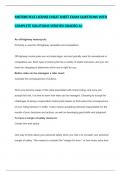Exam (elaborations)
MOTORCYCLE LICENSE CHEAT SHEET EXAM QUESTIONS WITH COMPLETE SOLUTIONS VERIFIED GRADED A+
MOTORCYCLE LICENSE CHEAT SHEET EXAM QUESTIONS WITH COMPLETE SOLUTIONS VERIFIED GRADED A+
An off-highway motorcycle:
Primarily is used for off-highway recreation and competition.
Off-highway motorcycles are not street-legal, and are typically used for recreational or competitive use. Each typ...
[Show more]
Preview 3 out of 20 pages
Uploaded on
May 10, 2024
Number of pages
20
Written in
2023/2024
Type
Exam (elaborations)
Contains
Questions & answers
All documents for this subject (281)
$9.99
Also available in package deal from $50.99
100% satisfaction guarantee
Immediately available after payment
Both online and in PDF
No strings attached
Also available in package deal (1)
FULL PACKAGE OF MOTORCYCLE PERMIT TEST EXAM QUESTIONS WITH COMPLETE SOLUTIONS VERIFIED GRADED A+
$ 264.71
$ 50.99
29 items
1. Exam (elaborations) - Motorcycle test for guam questions with complete 100% verified solutions 2024
2. Exam (elaborations) - Motorcycle test actual exam questions and verified correct answers graded a+
3. Exam (elaborations) - Motorcycle test exam questions and answers with complete 100% verified solutions
4. Exam (elaborations) - Dmv motorcycle test exam questions with complete solutions answered graded a+
5. Exam (elaborations) - Motorcycle permit test exam questions with complete solutions verified graded a+
6. Exam (elaborations) - Dmv motorcycle test exam questions with complete solutions answered 100% verified gra...
7. Exam (elaborations) - Motorcycle license test exam questions with complete 100% verified solutions graded a...
8. Exam (elaborations) - Motorcycle permit test exam questions with complete solutions verified graded a+
9. Exam (elaborations) - Icbc motorcycle test exam questions with complete verified answers graded a+
10. Exam (elaborations) - Massachusetts motorcycle permit test exam questions with complete solutions answered ...
11. Exam (elaborations) - Pa motorcycle permit test exam questions with complete solutions verified 100% guaran...
12. Exam (elaborations) - California dmv motorcycle written test exam questions with complete solutions verifie...
13. Exam (elaborations) - Motorcycle permit test questions and answers 100% verified solutions graded a+ 2024/2...
14. Exam (elaborations) - Michigan motorcycle test exam questions with complete 100% verified solutions already...
15. Exam (elaborations) - Mas motorcycle written study guide guam exam questions with complete solutions verifi...
16. Exam (elaborations) - Il motorcycle test exam questions with complete solutions and verified answers 2024/2...
17. Exam (elaborations) - Ca motorcycle test exam questions with complete solutions verified graded a+
18. Exam (elaborations) - Guam permit test exam questions with complete solutions verified graded a+
19. Exam (elaborations) - Illinois motorcycle permit test exam questions and verified correct answers graded a+
20. Exam (elaborations) - Motorcycle safety course exam questions with complete 100% verified solutions latest ...
21. Exam (elaborations) - Alabama motorcycle permit test exam questions with complete solutions graded a+
22. Exam (elaborations) - The motorcycle diaries exam questions with complete solutions verified graded a+
23. Exam (elaborations) - Indiana motorcycle permit exam questions with complete solutions verified graded a+
24. Exam (elaborations) - Washington motorcycle permit written test exam questions with complete solutions veri...
25. Exam (elaborations) - Motorcycles & sweetgrass content test exam questions with complete solutions verified...
26. Exam (elaborations) - Motorcycle for guam questions with complete 100% verified solutions 2024
27. Exam (elaborations) - Motorcycle license cheat sheet exam questions with complete solutions verified graded...
28. Exam (elaborations) - California motorcycle test (2024) exam questions with complete solutions answered cor...
29. Exam (elaborations) - Idaho written motorcycle test (2024) exam questions 100% solved completely verified g...
Show more
MOTORCYCLE LICENSE CHEAT SHEET EXAM QUESTIONS WITH




